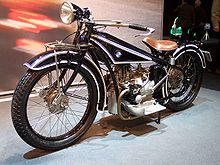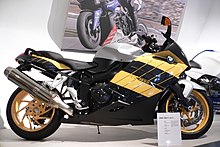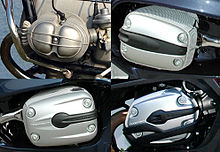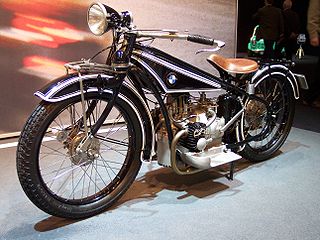
BMW's motorcycle history began in 1921 when the company commenced manufacturing engines for other companies. BMW's own motorcycles—sold under the BMW Motorrad brand—began in 1923 with the BMW R 32, which was powered by a flat-twin engine. Production of motorcycles with flat-twin engines continues to this day, however BMW has also produced many models with other types of engines.
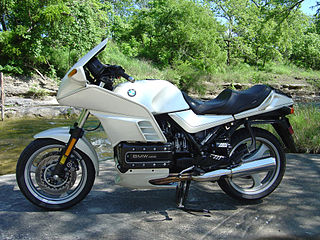
The BMW K100 is a family of four-cylinder 987 cc motorcycles that were manufactured by BMW from 1983 to 1992.

The BMW GS series of dual-sport BMW motorcycles have been produced from 1980, when the R80G/S was launched, to the present day. The GS originally stood for Gentleman's Scrambler, but was later renamed to Gelände/Straße. GS motorcycles can be distinguished from other BMW models by their longer travel suspension, an upright riding position, and larger front wheels – typically 19 to 21 inch. In May 2009, the 500,000th GS was produced, an R1200GS model.

The BMW R90S is a 900cc sport motorcycle produced by BMW from 1973 to 1976. BMW commissioned designer Hans Muth to oversee the R90S, which became the flagship of the boxer engined "/6" range. Sporting distinctive two-tone paintwork, a bikini fairing and a new tail, the R90S was intended to shrug off the enduring image of BMW bikes as staid and utilitarian.
The Killinger and Freund Motorcycle was an attempt in 1935 by a group of five German engineers from Munich to design a more streamlined and modified version of the German Megola front-wheel drive motorcycle. The work took three years to complete but the result was impressive. The engine displacement stayed the same as the Megola at 600 cc but was much lighter and more simplified than a standard 100 cc motorcycle of the time.
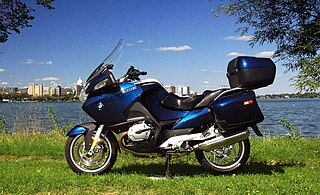
The BMW R1200RT is a touring or sport touring motorcycle that was manufactured from 2005 to 2019 by BMW Motorrad to replace the R1150RT model. It features a 1,170 cc (71 cu in) flat-twin engine with a six-speed gearbox and shaft drive.

The BMW R1200GS and R1200GS Adventure ("R1200GSA") are motorcycles manufactured in Berlin, Germany by BMW Motorrad, part of the BMW group. It is one of the BMW GS family of dual sport motorcycles. Both motorcycles have a 1,170 cc (71 cu in), two-cylinder boxer engine with four valves per cylinder. The Adventure has a large-capacity fuel tank and long travel suspension. As of 2012, BMW's R1200GS bikes are their top-selling models.

The BMW R1100GS is a dual-sport motorcycle that was launched in 1993, and manufactured from 1994 to 1999 by BMW Motorrad in Berlin, Germany. The bike has a 1,085 cc (66.2 cu in) flat-twin (boxer) engine, first seen in the R1100RS which was launched the year before in 1992, and was the first member of the GS family to use an air- and oil-cooled engine rather than the earlier air-cooled airhead engines which had been used on BMW motorcycles since the R32 in 1923.

A motorcycle fork connects a motorcycle's front wheel and axle to its frame, typically via a yoke, also known as a triple clamp, which consists of an upper yoke joined to a lower yoke via a steering stem, a shaft that runs through the steering head, creating the steering axis. Most forks incorporate the front suspension and front brake, and allow the front wheel to rotate about the steering axis so that the bike may be steered. Most handlebars attach to the top clamp in various ways, while clip-on handlebars clamp to the fork tubes, either just above or just below the upper triple clamp.

For the WWII-era motorcycle, see BMW R75

The BMW F series is a family of parallel-twin engine dual-sport motorcycles manufactured in Berlin, Germany by BMW Motorrad. Launched in 2008, the range comprises the F650GS, F700GS, F800GS, and F800GSA. In 2012, the F700GS replaced the discontinued F650GS, and in 2013, the F800GSA was introduced with a 24-litre fuel tank and a larger front fairing and screen. The F800GT and F800S both have belt drive.

The BMW R65 is a light touring motorcycle introduced by BMW in 1978 to add a mid-size motorcycle to its product line. The original R65, contrary to the views of some commentators, has the same sized frame as the larger R series motorcycles. The R65 does however have a shorter swingarm than its siblings and therefore a shorter bolt-on rear sub-frame; this, along with the shorter front forks and 18" front wheel, gives the illusion that the R65 frame is smaller. The initial model R65 was manufactured until 1984. In 1985 the R65’s engine was put into the same frame and suspension as the R80 which featured a single rear shock absorber (mono-shock). Additionally, between 1981 and 1984, the R65LS was manufactured. This R65 variant has a small triangular fairing that was designed by Hans Muth.

The BMW R 80 G/S is a motorcycle that was manufactured in Berlin, Germany, by BMW Motorrad from 1980 to 1987. Production totalled 21,864 bikes. It was the first in the BMW GS family of specialised dual-sport bikes, of which over 500,000 have been produced, and is often considered the world's first "Adventure Bike" able to be equally capable on and off-road. The designation G/S stands for the German words Gelände/Straße, which mean offroad/road – highlighting the bike's dual sport design.

The BMW K1600GT, K1600GTL, and K1600B are motorcycles manufactured by BMW Motorrad. The former two were announced in July 2010, unveiled at the Intermot motorcycle show in Cologne in October 2010; they went on sale in March 2011. The latter was announced in October 2016. The K1600GTL is a full dress luxury tourer, which replaced the K1200LT. It was intended to compete with the Honda Gold Wing. The K1600GT was more of a sport tourer similar to the then-existing K1300GT and previous K1200GT models. The K1600B is a bagger designed primarily for the North American market.

The BMW R1100RS is a sport-touring motorcycle that was manufactured by BMW Motorrad between 1993 and 2001, and was the first BMW motorcycle to use the R259 "Oilhead" boxer engine.

The BMW R1100S is a sports motorcycle that was manufactured by BMW Motorrad between 1998 and 2005. Introduced some 25 years after the R90S, the company's first sports bike, the R1100S was the first BMW bike having clip-on handlebars, rearset footrests and a removable cowl to cover the pillion seat. Producing nearly 100 hp, it has been described as a "sporty sports-tourer".

The BMW R nineT is a standard motorcycle made by BMW Motorrad since 2014. It is a retro styled roadster marketed by BMW to custom builders and enthusiasts as a "blank canvas for customizing".

The BMW HP2 Sport is a boxer-engined sports motorcycle produced by BMW Motorrad from 2008 to 2012. It is the successor to the BMW R1200S.
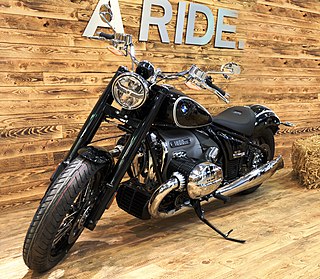
The BMW R 18 is a cruiser motorcycle manufactured by BMW Motorrad and was officially introduced in April 2020 and launched in September 2020 in Germany. Due to the COVID-19 pandemic, an official introduction at the BMW dealers was not possible, therefore it was presented virtually on the internet.

The G450X is an Enduro-class motorcycle that was produced by BMW Motorrad between 2008 and 2011.
